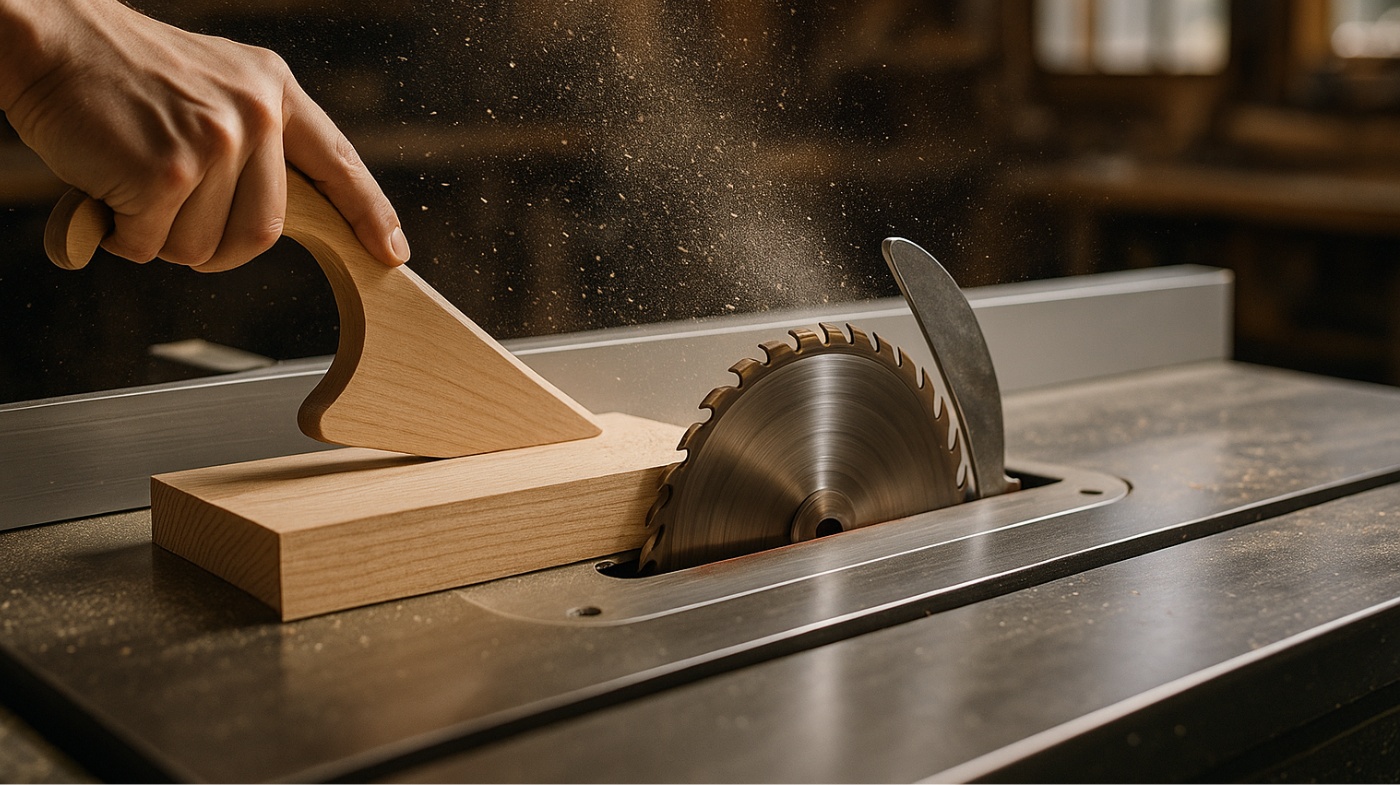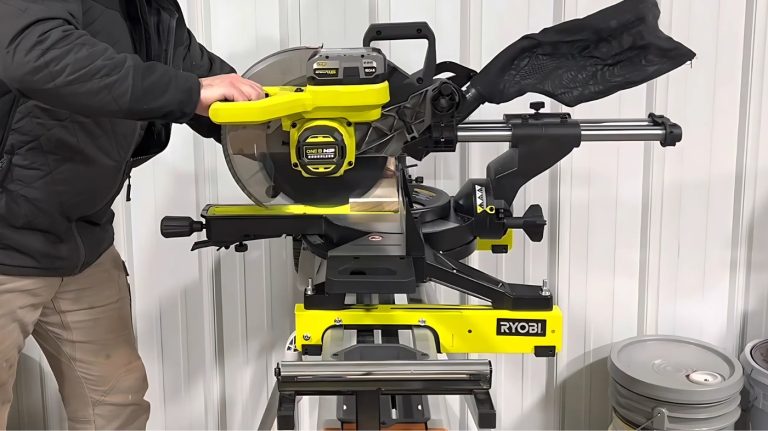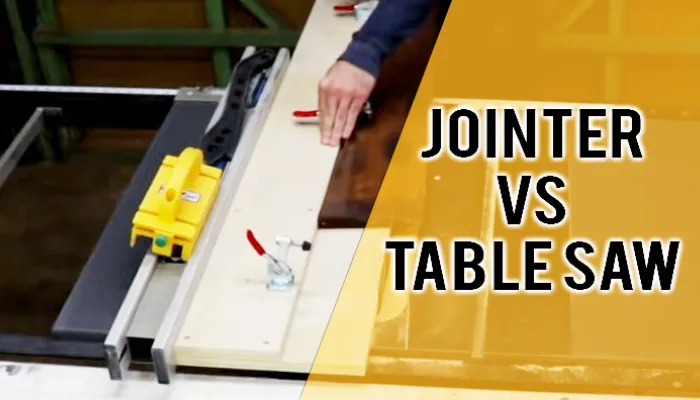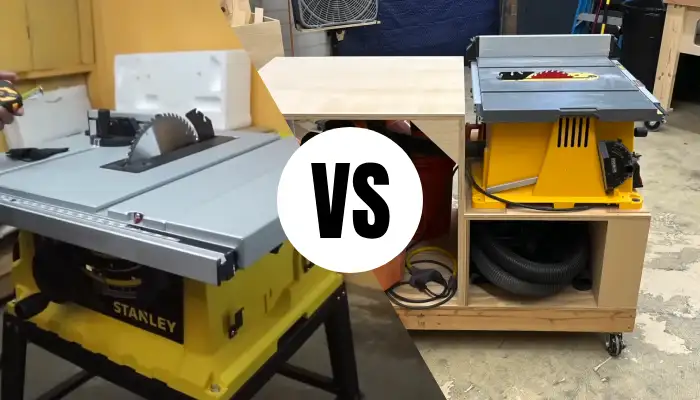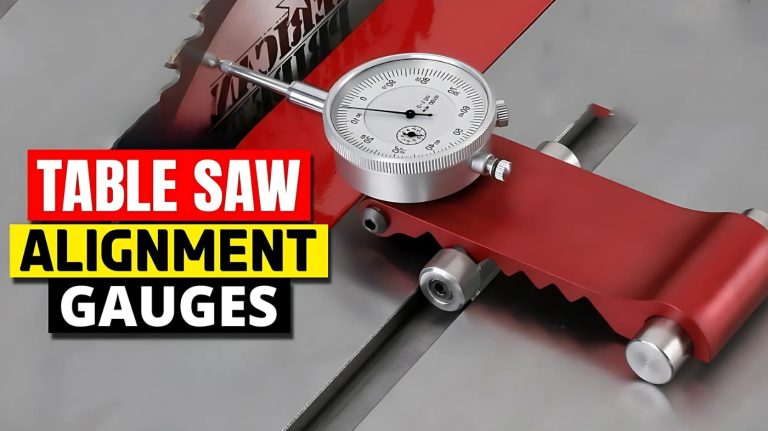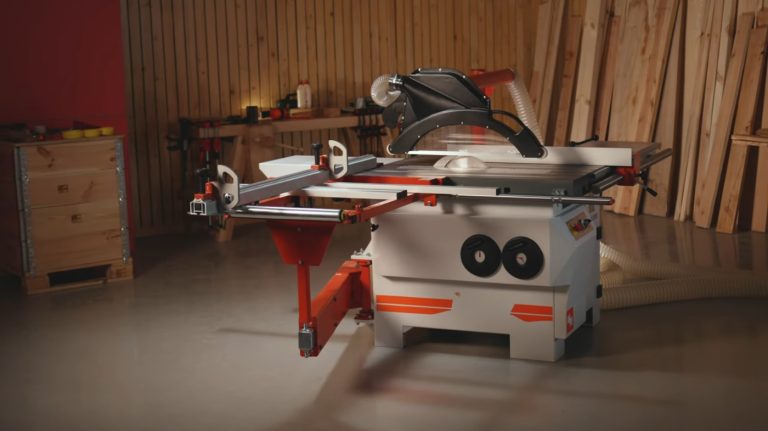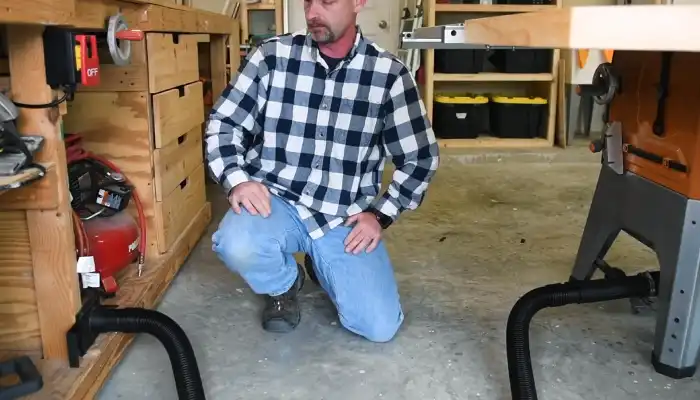How to Avoid Kickback on Table Saw? Some Smart Safety Hacks
To avoid kickback on your table saw, always use a properly aligned riving knife positioned just behind the blade to prevent wood pinching.
Keep the fence parallel to the blade and guarantee the blade is sharp and suitable for your cut type. Inspect workpieces for defects and use push sticks to keep your hands safely away.
Stand out of the blade’s direct line and maintain a clean work environment. Mastering these fundamentals sets the foundation for safer, more accurate cutting—there’s more to optimize beyond these basics.
Key Takeaways
- Use a riving knife aligned closely behind the blade to prevent the workpiece from pinching and causing kickback.
- Keep the fence parallel to the blade and miter slot to ensure stable, accurate cuts and reduce binding risks.
- Inspect and prepare workpieces by removing knots, splits, and debris to avoid sudden blade binding.
- Use push sticks to keep hands away from the blade, especially when cutting narrow or small pieces.
- Maintain sharp, appropriate blades and avoid standing directly in line with the blade to minimize exposure to kickback.
The Dangers of Kickback
Although table saws are essential woodworking tools, you must understand the dangers of kickback to operate them safely.
Kickback occurs when the workpiece binds between the blade and fence or when blade teeth grab the wood fibers, violently ejecting material toward you.
Factors like warped lumber, internal stresses, or dull blades increase binding risk, while excessive blade height encourages workpiece lift-off. Kickback can happen in a fraction of a second, making it extremely dangerous due to its suddenness. Using a riving knife helps prevent kickback by keeping the kerf open and material stable during cuts.
Kickback happens when wood binds or is grabbed by the blade, often due to warped lumber or dull blades.
The high-speed projectile can cause severe injuries including fractures and lacerations, while sudden blade contact risks severe cuts. Additionally, kickback may throw you off balance, leading to secondary accidents.
Installing and Using a Riving Knife
When you install a riving knife on your table saw, you greatly reduce the risk of kickback by preventing the workpiece from pinching behind the blade.
Splitters and riving knives are designed to prevent wood pinching during cuts, which enhances safety. Begin by aligning the knife parallel to the blade using the manufacturer’s adjustment screws, positioning it 3-8mm behind the blade teeth depending on your saw model and blade size.
Secure the attachment block firmly to prevent lateral movement, and verify vertical alignment matches the blade angle during bevel cuts. Because riving knives move with the blade, they maintain consistent alignment, offering superior protection compared to fixed splitters.
Set the knife height just below the highest tooth to maintain clearance. Never remove the knife except for special cuts like dado stacks. Use it in tandem with the blade guard and anti-kickback pawls for maximum safety.
Regularly inspect and clean the knife, checking alignment monthly to guarantee reliable operation. Proper maintenance also ensures compliance with UL safety standards for table saws.
Aligning the Fence and Blade Correctly
Accurate alignment of the fence and blade is essential for both safety and precision on your table saw. Begin by verifying the fence is perfectly parallel to the blade and the miter slot. Use a dial indicator or an engineer’s square to measure and confirm these alignments meticulously.
Adjust the fence using set screws, making incremental changes and checking flushness at both ends for consistent spacing. Regular checks are necessary for optimal operation to maintain this alignment over time. Misaligned fences can cause inaccurate cuts, so it’s important to secure the fence firmly to prevent movement during use.
Regularly perform visual and tactile inspections—sliding your finger along the miter slot helps detect misalignment. Lock the fence securely after adjustments to prevent movement during operation.
Maintain cleanliness and lubricate moving parts to guarantee smooth fence motion. This precise alignment minimizes binding and kickback risks, ensuring safer, more accurate cuts every time you use your table saw.
Selecting and Maintaining the Right Blades
To minimize kickback, you need to select blades that match your material and cutting style. Below are some key tips to help you choose the right blade and keep it in top condition for safer, smoother cuts.
Blade Selection Tips
Although selecting the right blade may seem straightforward, choosing one tailored to your specific cutting needs critically impacts both performance and safety.
Use ripping blades with fewer teeth (around 24) for fast cuts along the grain and crosscutting blades with 60 to 100 teeth for precision across the grain. Combination blades offer versatility but sacrifice specialization. For plywood, selecting blades with a higher tooth count helps minimize tear-out and achieve smoother finishes.
For sheet goods like plywood or MDF, opt for ATB or TCG tooth designs. Prioritize carbide-tipped blades for durability, especially under heavy use, and consider coatings that reduce friction and wear. Understanding hook angles can further aid in selecting blades that provide efficient and controlled cuts.
Proper tooth count enhances cut quality—higher counts yield cleaner, slower cuts. Guarantee blade stability and correct alignment to reduce kickback risks. Selecting a blade matched to material and cut type guarantees efficient, safe operation on your table saw.
Blade Maintenance Practices
When you maintain your table saw blades properly, you not only extend their lifespan but also assure consistent cutting performance and reduce the risk of kickback.
Start by cleaning blades regularly using specialized cleaners like Simple Green and soft nylon brushes to remove pitch buildup without damaging carbide teeth. Rinse and thoroughly dry blades to prevent rust.
Inspect blades frequently for wear, alignment, and tension, especially in humid environments. Avoid direct contact with the blade’s cast iron surfaces and store blades in dry conditions.
Before cleaning, always ensure the saw is unplugged to maintain safety precautions. Follow manufacturer guidelines for handling and maintenance. Additionally, maintain your table saw by cleaning debris with a shop vac and applying paste wax to protect surfaces.
Adopting Safe Operational Practices
Since kickback can cause serious injury, you must adopt safe operational practices rigorously when using a table saw.
Stand to the left of the blade with feet shoulder-width apart on a non-slip surface, maintaining a balanced stance and avoiding reaching over the blade. Always position your body sideways, never directly behind the workpiece.
It is important to avoid standing directly in line with the blade to reduce exposure to the danger zones. Using a push stick can further enhance safety by keeping your hands away from the blade.
Never crosscut against the rip fence; use a miter gauge or sled instead, and verify fence parallelism before cutting. Apply consistent pressure against the fence without twisting, and switch to push sticks once your hands approach six inches from the blade.
Initiate cuts with the leading edge flat on the table and maintain continuous forward motion. Keep the workspace clear of debris and guarantee adequate lighting. Always shut off the blade if binding occurs—never force removal.
Preparing Workpieces for Safe Cutting
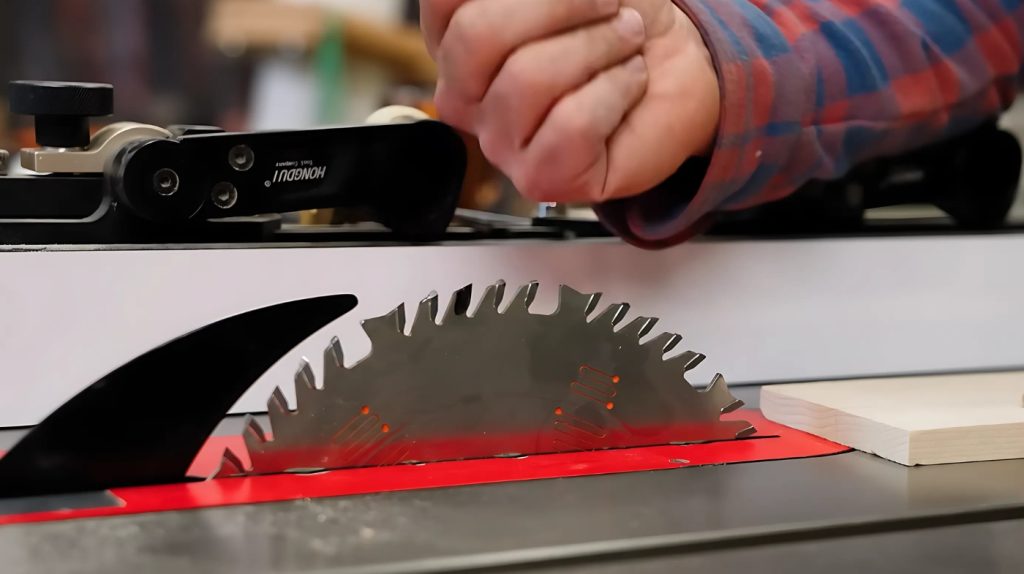
Before making any cuts, you need to properly prepare your workpieces to ensure stability and control. Below are essential steps to follow for safe cutting.
Inspect Workpiece Thoroughly
Although inspecting your workpiece may seem straightforward, thorough examination is essential to prevent kickback on a table saw.
Begin by identifying any twists, warps, cracks, or splits that can cause uneven cuts or sudden breaks. Verify the absence of embedded metal, nails, or other obstacles that could damage the blade and trigger kickback.
Confirm that the board is properly oriented relative to the fence and blade rotation to guarantee controlled feeding. Evaluate support on both the infeed and outfeed sides to prevent tipping or binding during the cut.
Using sharp blades also helps reduce the likelihood of kickback by allowing smoother cuts with less force. Additionally, ensuring the proper use of riving knives can significantly enhance safety by preventing material from pinching the blade.
Additionally, check the work area for obstructions and verify the workpiece dimensions suit the saw’s capacity. This systematic inspection reduces risks, promotes stability, and maintains precise cutting conditions critical for safe table saw operation.
Ensure Flat, Straight Wood
Flat, straight wood forms the foundation for safe and accurate table saw cutting, minimizing the risk of kickback and ensuring clean cuts.
Begin by flattening one face using a jointer or a table saw with runners as a makeshift jointer. For large boards, use hand planes or belt sanders, securing the wood with clamps to prevent warping. When space is limited and a jointer is not available, you can create a custom tool using square aluminum stock to help straighten wood.
Next, create a straight edge by running the wood against the rip fence, adjusting the fence precisely to the saw blade’s thickness. Always straighten concave edges first for stable fence contact.
Then, rip the opposite edge parallel, maintaining consistent pressure and smooth feed. Secure the workpiece firmly during cuts and support long boards to avoid movement. Finally, verify edges are square and parallel before proceeding to dimension the workpiece.
Utilizing Push Sticks and Safety Guards
Three key tools—push sticks, push blocks, and safety guards—are essential for maintaining control and preventing kickback on your table saw. Use push sticks when your hands are within 6″ of the blade or for workpieces under 12″ long.
Position them to apply downward pressure, avoiding sideways force that causes binding. It is also important to stand to the left of the saw blade to minimize the risk of kickback. Always keep your work area clean and free of obstacles to maintain focus and safety.
Always keep blade guards installed except during specialized cuts, ensuring they sit about ¼” above the workpiece for ideal protection. Combine guards with anti-kickback pawls for added safety.
- Choose ergonomic push sticks with non-slip bases and replace worn tools promptly
- Use clear push blocks to maintain visibility near the blade
- Never bypass guards during rip or crosscuts
- Pair push sticks with featherboards and riving knives for consistent pressure and [blade stability
Performing Regular Saw Maintenance and Inspections
Maintaining control during cuts with push sticks and safety guards is only part of preventing kickback—keeping your table saw in proper working order plays an equally important role.
Regularly sharpen blades, replace warped or damaged ones, and clean resin buildup to reduce friction. Dull blades struggle to cut stock effectively and increase the risk of kickback, so blade maintenance is crucial. Align the blade perpendicular to the table and verify the rip fence runs parallel without “toed-in” positioning to avoid workpiece pinching.
Inspect and secure riving knives or splitters, matching their thickness to the blade kerf for ideal separation. Maintain stable work surfaces, tighten arbor nuts, lubricate trunnions, and check belts for wear.
Frequently calibrate fences and miter gauges using precision tools. Finally, test safety mechanisms monthly and clean dust systems to prevent overheating. Consistent maintenance considerably lowers kickback risks and guarantees precise, safe cuts.
Frequently Asked Questions
Can Kickback Occur With Other Types of Saws Besides Table Saws?
Yes, kickback can happen with several saw types besides table saws. Circular saws often experience kickback when their blades bind during cutting.
Chainsaws can jerk back if the chain bites too aggressively, especially with shorter bars. While miter saws rarely cause kickback, improper guard use can lead to injuries.
Band saws are less prone but can cause accidents if the material slips. You need to understand each saw’s risks to stay safe.
What Is the Best Personal Protective Equipment for Preventing Kickback Injuries?
Think of PPE as your last line of defense when kickback strikes. You’ll want a full-face shield to block airborne debris and a heavy-duty apron to protect your torso from flying projectiles.
While anti-cut gloves might seem helpful, they can increase entanglement risk and aren’t recommended. Thick-soled shoes safeguard your feet from dropped pieces.
How Does Humidity or Wood Moisture Content Affect Kickback Risk?
Humidity increases wood moisture, causing swelling and internal stresses that can pinch your blade and close the kerf during cutting.
Wet wood raises friction and blade temperature, dulling teeth faster and increasing binding risk. Moisture also makes fibers pliable and grain unpredictable, amplifying kickback forces.
You must measure moisture and adjust feed rates accordingly; otherwise, you risk sudden, dangerous workpiece movement due to moisture-induced dimensional changes and tension.
Are There Specific Brands Known for Better Anti-Kickback Safety Features?
Did you know that SawStop’s blade-stopping technology can reduce kickback injuries by over 90%? When choosing a table saw, you’ll want brands like SawStop, Bosch, DeWalt, Festool, and Powermatic. They incorporate advanced anti-kickback features such as riving knives, flesh-sensing technology, and robust blade guards.
Investing in these brands guarantees you’re using cutting-edge safety systems designed to protect you effectively during operation.
Can Using a Zero-Clearance Insert Help Reduce Kickback Chances?
Using a zero-clearance insert can help reduce kickback by minimizing the gap around your saw blade, preventing small offcuts from falling into the blade well and causing binding.
It also supports material edges, reducing tear-out and stabilizing cuts. However, it doesn’t replace a riving knife’s anti-kickback function, so you should use it alongside proper safety devices and techniques to effectively lower kickback risks.
Keep the Safety Tips in Mind for a Smooth, Kickback-Free Cutting Experience
Avoiding kickback on your table saw is like steering a ship through rocky waters—you need precise control and constant vigilance. By installing a riving knife, aligning your fence and blade accurately, using the right blades, and maintaining your saw regularly, you minimize risks effectively.
Always prepare your workpieces properly and use push sticks and safety guards. These disciplined practices guarantee your cutting remains safe, smooth, and predictable every time you power up your saw.

